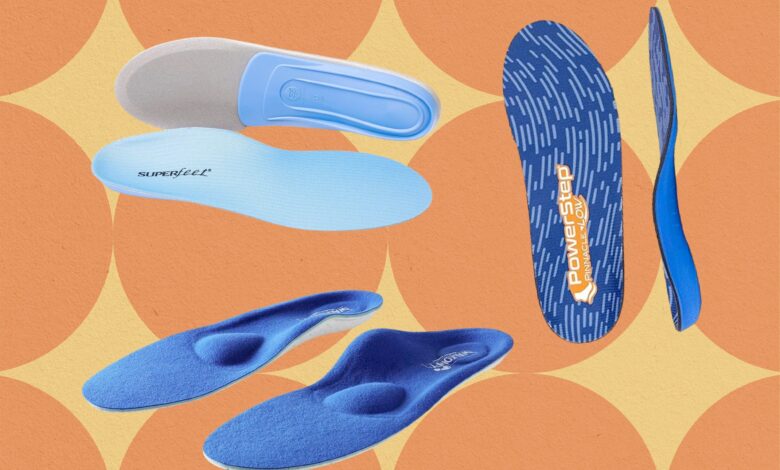9 Best Insoles for Flat Feet in 2024, According to Experts

- Sizes: US 6 to 10 | Materials: N/A
Best Thin Option: Samurai Insoles Arch Support Shoe Insoles
Samurai Insoles
Arch Support Shoe Insoles
Pros
- Lightweight
- Flexible
Cons
- Not a good option if you want more cushioning
Designed by a podiatrist who struggled with his own foot pain, this insole from Samurai is made to reduce the discomfort that results from both flat feet and plantar fasciitis. It has a slightly flexible, responsive orthotic core built into the midfoot and heel, which allows it to both bend with your foot and prevent it from rolling inward. This insole is a little thinner than the other options on our list, so it’s a good pick if you want something that won’t add a ton of bulk to footwear like dress shoes.
- Sizes: US 6-6.5 to 13-13.5 | Materials: EVA, plastic, foam, synthetic fabric
Best Stiff Option: Powerstep Pinnacle Maxx Support Insoles
Powerstep
Pinnacle Maxx Support Insoles
Pros
- Sturdy and stabilizing
- Odor-controlling top layer
Cons
- May be too thick and rigid for some
The Pinnacle Maxx Support insole from Powerstep is seriously sturdy—it has a firm, mid-height arch and a deep, angled heel cup that’s meant to prevent your foot from slipping around or pronating. It’s still comfortable and cushioned, so you can wear it in your everyday shoes, from sneakers to work boots, without concern.
- Sizes: US 5-5.5 to 12 | Materials: EVA, plastic, foam, polyester | Odor-resistant
What causes flat feet?
As SELF has previously reported, flat feet—or arches that are nearly or completely flush with the floor when you’re standing—can be genetic or you could develop them later in life. “Fallen arches,” as this is sometimes called, can be the result of an injury, weakness in the muscles and tendons in the bottom of your foot, or simply getting older.
Pregnancy can also cause your arches to flatten. During pregnancy, your body increases production of a hormone called relaxin to help loosen the ligaments and muscles around your pelvis—but that increase loosens all your ligaments, including the ones in your feet. When you add pressure to those newly relaxed ligaments (say, by walking), your arches are more likely to collapse and flatten. For most people, that change is irreversible.
Do you really need insoles if you have flat feet?
For most people, having flat feet isn’t a major problem, Dr. Lobkova says. That said, if you sit or stand for long periods of time, flat feet can contribute to arch, knee, hip, and back pain. This is because flat feet can cause your ankles and lower legs to roll inward, which can lead to knee pain and shin splints (especially if you’re a runner). Fallen arches may also increase your likelihood of developing calluses, as the inside of your foot has a greater tendency to rub and chafe against your shoes.
If you deal with any of these discomforts, a shoe insert could help provide more support and stability—and hopefully relieve some of your pain, Alissa Kuizinas, DPM, a podiatrist at Wellness in Motion Boston, tells SELF.
What should you look for in an insole?
Most of our picks have key design elements in common, which you can keep in mind while you shop for your own insoles. For one thing, an OTC insole should have a heel cup that is deep enough to cradle the back of your foot, Dr. Sims says. That snug fit will help keep your foot stable and supported, he explains.
For further stability, look for a stiff insole, says Dr. Sims. He cautions against products that advertise a lot of cushioning, because the more rigid the insole, the more supportive it’ll be. Here’s an easy test: If you can easily fold an insole, or even roll it up, it’s likely too soft. An overly flexible insert may actually contribute to foot and ankle instability instead of managing it.


